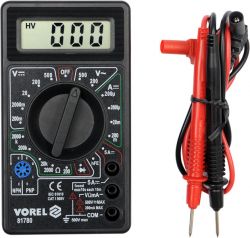In the next article devoted to the gadget that has a chance to appear in the Elektrody shop, I would like to present you a very small and handy multimeter (or actually a "multimeter") of Chinese production (of course, of course).
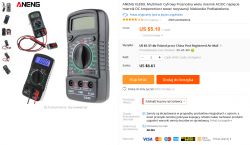
For the price of about five dollars, we can buy a very cheap and tiny "gauge".
Although this "toy, together with the 6F22 battery (which is not included), weighs more or less as much as the battery, to my surprise it is quite a functional multimeter. However, for less than PLN 20 with shipping, there is nothing to complain about. it even had boxes, was wrapped in shrink wrap and wrapped in bubble wrap.
The set also includes "test leads". However, their quality leaves much to be desired. So I used my own.
Below, I present a dozen or so photos showing the comparison of measurements with the "meter" that I use every day. It is impossible to disagree with the facts. This little Chinese "cockroach" looks perfectly correct as far as the measurement results are concerned.
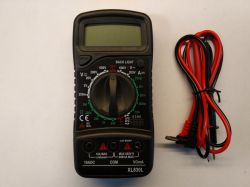
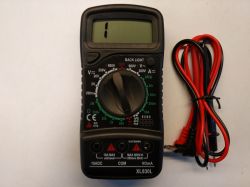

On the above photos you can clearly see how tiny this "multimeter" is. Unfortunately, the thickness is close to "standard" multimeters. You can also see that it has a screen backlight. However, once it is turned on, it cannot be turned off. You have to set the selector knob to OFF, thus turning off the entire device. When turned on again, the backlight will be off by default.
There is also a HOLD button that allows you to "freeze" the result of the current measurement.

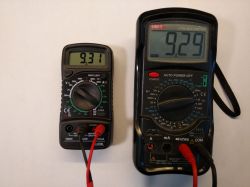

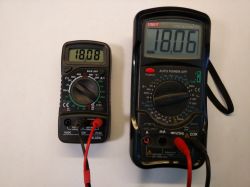
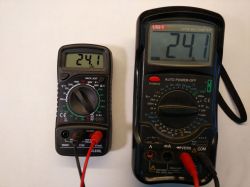
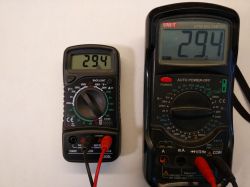
The photos at the top show a comparison of DC voltage measurements ranging from five to thirty volts. My power supply doesn't really give the full 30V, but we can skip that.

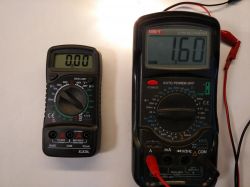
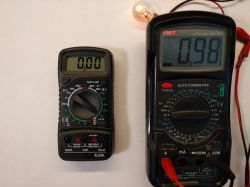
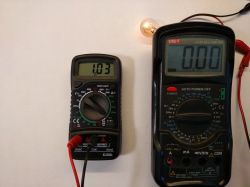
Here (above) we can see the current measurement (interestingly, the meter "can" measure only direct current),. As you know, ammeters should not be connected in parallel or in series (and here you have a chance to prove yourself and write why). Therefore, the measurement is performed alternately on both multimeters. On the same test leads.
A 12V 21W car bulb was used as the load. The supply voltage in the first case was 12V, and 5V in the second.
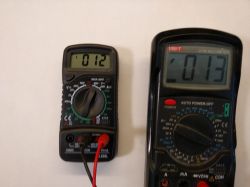

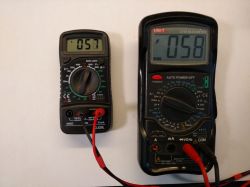
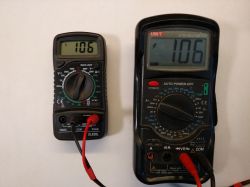

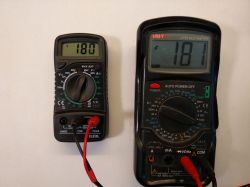

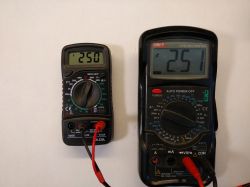
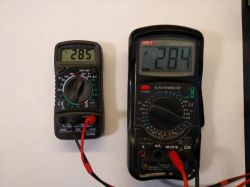
Alright. DC voltage, it measures quite correctly. So let's see how this little one deals with AC. In the pictures above I have recorded a comparison of measurements in the range of 12VAC to 285VAC.
Now it's time to test the ohmmeter:
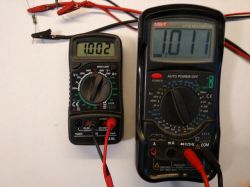
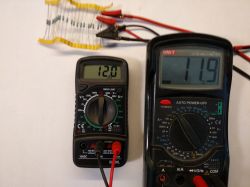
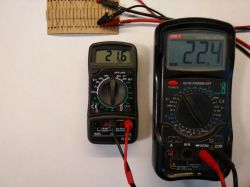
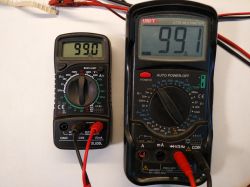
As you can see in the photos above and below, when measuring resistance, the results are perfectly acceptable. Especially since, as you probably noticed, the measurements (due to my laziness) were made on two different resistors from the same package. And we know that even in one "strip" of 100 pieces, they will be different.

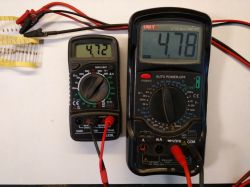
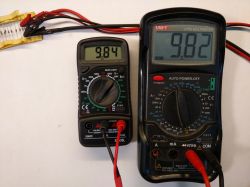
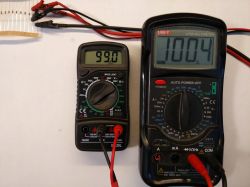
I have not tested the HFE measurement of transistors, because although I have this function in all my multimeters, I have never used them in my professional or amateur career.
I forgot one more important thing. I scanned the user manual for you.

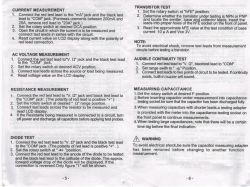
Summarizing.
It is quite a useful tool (apart from the tragic quality of test leads). If it appears in the electrode shop, it will certainly be useful to many young electronics enthusiasts. And even if someone spends the $ 5 and buys them on their own, and then "measures", for example, the resistance in a 230V socket, it will not be a regret.
Best regards.
CMS
EDIT: 2018-07-26 16:53
At the user's request, I add photos from the center of the multimeter.
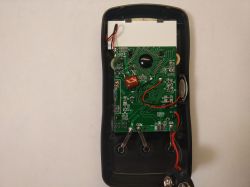
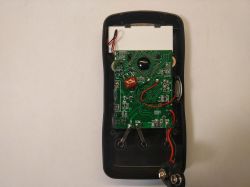
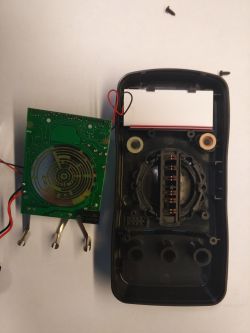
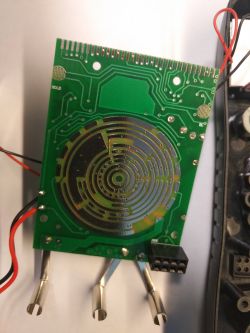
As you suspected, we will not find out what integrated circuit the meter is built on, because we only have a "black dot".

For the price of about five dollars, we can buy a very cheap and tiny "gauge".
Although this "toy, together with the 6F22 battery (which is not included), weighs more or less as much as the battery, to my surprise it is quite a functional multimeter. However, for less than PLN 20 with shipping, there is nothing to complain about. it even had boxes, was wrapped in shrink wrap and wrapped in bubble wrap.
The set also includes "test leads". However, their quality leaves much to be desired. So I used my own.
Below, I present a dozen or so photos showing the comparison of measurements with the "meter" that I use every day. It is impossible to disagree with the facts. This little Chinese "cockroach" looks perfectly correct as far as the measurement results are concerned.



On the above photos you can clearly see how tiny this "multimeter" is. Unfortunately, the thickness is close to "standard" multimeters. You can also see that it has a screen backlight. However, once it is turned on, it cannot be turned off. You have to set the selector knob to OFF, thus turning off the entire device. When turned on again, the backlight will be off by default.
There is also a HOLD button that allows you to "freeze" the result of the current measurement.






The photos at the top show a comparison of DC voltage measurements ranging from five to thirty volts. My power supply doesn't really give the full 30V, but we can skip that.




Here (above) we can see the current measurement (interestingly, the meter "can" measure only direct current),. As you know, ammeters should not be connected in parallel or in series (and here you have a chance to prove yourself and write why). Therefore, the measurement is performed alternately on both multimeters. On the same test leads.
A 12V 21W car bulb was used as the load. The supply voltage in the first case was 12V, and 5V in the second.









Alright. DC voltage, it measures quite correctly. So let's see how this little one deals with AC. In the pictures above I have recorded a comparison of measurements in the range of 12VAC to 285VAC.
Now it's time to test the ohmmeter:




As you can see in the photos above and below, when measuring resistance, the results are perfectly acceptable. Especially since, as you probably noticed, the measurements (due to my laziness) were made on two different resistors from the same package. And we know that even in one "strip" of 100 pieces, they will be different.




I have not tested the HFE measurement of transistors, because although I have this function in all my multimeters, I have never used them in my professional or amateur career.
I forgot one more important thing. I scanned the user manual for you.


Summarizing.
It is quite a useful tool (apart from the tragic quality of test leads). If it appears in the electrode shop, it will certainly be useful to many young electronics enthusiasts. And even if someone spends the $ 5 and buys them on their own, and then "measures", for example, the resistance in a 230V socket, it will not be a regret.
Best regards.
CMS
EDIT: 2018-07-26 16:53
At the user's request, I add photos from the center of the multimeter.
piotr_go wrote:Please pics from inside.




As you suspected, we will not find out what integrated circuit the meter is built on, because we only have a "black dot".
Cool? Ranking DIY







